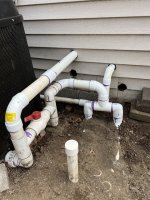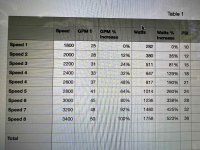Hi,
My GPM for my pump was highly inefficient according to everyone I talked to, and upon doing research found that switching from 90 degree elbows to 90 degree SWEEP elbows should help, and re-plumbing to eliminate unnecessary 90 degree turns would also help. Before I began to re-do the plumbing, I counted 20 90 degree elbows. So today I ripped out all of my above ground plumbing and streamlined it, ended up with 13 - 90 degree SWEEP elbows and 2 - 90 degree elbows (I eliminated 5 elbows completely). As soon as I open up the pool in the next couple of weeks, I'll let you know how much more efficient the plumbing is. I have documented the number of Watts per GPM before I made the changes. I'll run the same test, hopefully it takes less Watts to run the same GPM. Any thoughts if this will work? I've attached the new plumbing photos.
My GPM for my pump was highly inefficient according to everyone I talked to, and upon doing research found that switching from 90 degree elbows to 90 degree SWEEP elbows should help, and re-plumbing to eliminate unnecessary 90 degree turns would also help. Before I began to re-do the plumbing, I counted 20 90 degree elbows. So today I ripped out all of my above ground plumbing and streamlined it, ended up with 13 - 90 degree SWEEP elbows and 2 - 90 degree elbows (I eliminated 5 elbows completely). As soon as I open up the pool in the next couple of weeks, I'll let you know how much more efficient the plumbing is. I have documented the number of Watts per GPM before I made the changes. I'll run the same test, hopefully it takes less Watts to run the same GPM. Any thoughts if this will work? I've attached the new plumbing photos.





